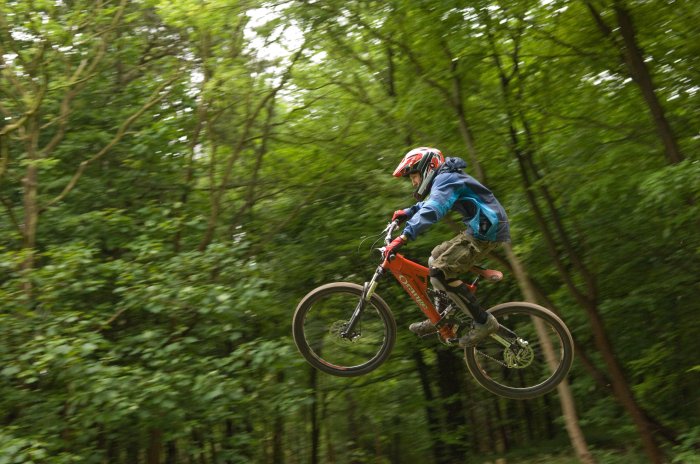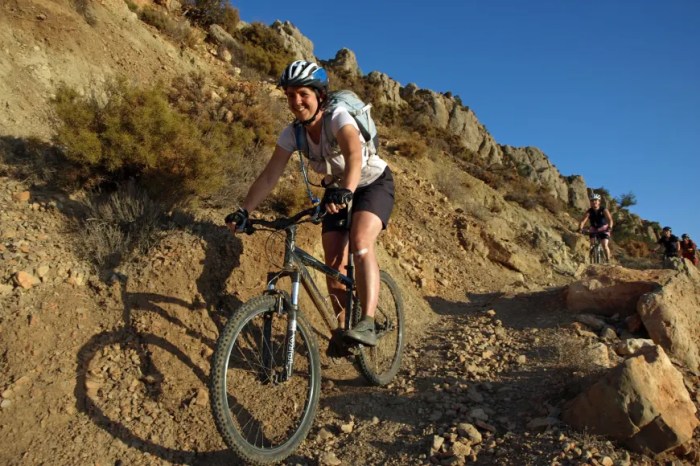
Off-Road Cycling Adventures sets the stage for this enthralling narrative, offering readers a glimpse into a story that is rich in detail with casual formal language style and brimming with originality from the outset.
Embark on a journey through rugged terrains and scenic trails, as we delve into the world of off-road cycling adventures and discover the exhilaration it brings to enthusiasts.
Introduction to Off-Road Cycling Adventures

Off-road cycling, also known as mountain biking, involves riding bicycles off paved roads and onto rugged terrains such as dirt trails, rocky paths, and forest tracks. It offers a thrilling and challenging experience for cycling enthusiasts looking to explore nature in a unique way.
The Appeal of Off-Road Cycling Adventures
Off-road cycling adventures appeal to many individuals due to the sense of freedom and adventure they provide. The opportunity to navigate through diverse landscapes, encounter wildlife, and feel the adrenaline rush of conquering difficult trails adds excitement to the cycling experience.
Benefits of Engaging in Off-Road Cycling Trips
- Physical Fitness: Off-road cycling is a great way to improve cardiovascular health, build strength, and enhance overall fitness levels.
- Mental Well-being: The connection with nature and the thrill of overcoming obstacles can reduce stress and improve mental well-being.
- Exploration: Off-road cycling allows riders to explore remote and scenic locations that are inaccessible by car, providing a unique sense of adventure.
- Skill Development: Riding on challenging terrains helps cyclists improve their balance, coordination, and bike handling skills.
- Social Interaction: Joining off-road cycling groups or clubs can lead to forming friendships with like-minded individuals who share a passion for outdoor activities.
Planning an Off-Road Cycling Adventure
When embarking on an off-road cycling adventure, proper planning is key to ensuring a safe and enjoyable experience. This includes selecting the right destination, having essential gear and equipment, and considering safety measures.
Selecting the Right Off-Road Cycling Destination
When choosing a destination for your off-road cycling adventure, consider factors such as terrain difficulty, trail length, and scenic views. Research the area to ensure it aligns with your skill level and preferences. Look for trails that offer a mix of challenges and rewards to make the most of your cycling experience.
Essential Gear and Equipment
- Mountain Bike: Choose a bike suitable for off-road terrain, with durable tires and good suspension.
- Helmet: Protect your head with a quality helmet that meets safety standards.
- Appropriate Clothing: Wear moisture-wicking clothes and padded cycling shorts for comfort.
- Repair Kit: Carry tools, spare tubes, and a pump for on-trail fixes.
Having the right gear and equipment can enhance your off-road cycling adventure and ensure you are prepared for any situation that may arise.
Safety Measures to Consider
- Plan Your Route: Familiarize yourself with the trail map and let someone know your planned route and estimated return time.
- Stay Hydrated: Carry an adequate supply of water to stay hydrated throughout your ride.
- Obey Trail Rules: Respect trail etiquette and yield to other users when necessary to ensure a safe and enjoyable experience for everyone.
- Emergency Contact: Carry a fully charged phone and know the emergency contact numbers for the area you are riding in.
By following these safety measures, you can minimize risks and focus on enjoying your off-road cycling adventure to the fullest.
Best Off-Road Cycling Destinations
Off-road cycling enthusiasts are always on the lookout for new and exciting destinations to explore. From well-known hotspots to hidden gems, there are plenty of amazing places around the world to satisfy your adventurous spirit. Here are some of the best off-road cycling destinations that are sure to thrill any cyclist:
1. Moab, Utah, USA
Moab is a mecca for mountain bikers, with its stunning red rock landscapes and challenging terrain. The Slickrock Trail is a must-ride for experienced cyclists, offering technical climbs and descents with breathtaking views of the surrounding desert.
2. Whistler, British Columbia, Canada
Whistler is known for its world-class mountain biking trails, including the famous Whistler Bike Park. With a variety of trails catering to all skill levels, riders can enjoy everything from flowy singletrack to adrenaline-pumping downhill runs.
3. Rotorua, New Zealand
Rotorua is a paradise for off-road cyclists, with its geothermal landscapes and lush forests providing the perfect backdrop for a thrilling ride. The Redwoods Forest offers a network of trails for riders of all abilities, making it a popular destination for mountain biking enthusiasts.
4. Sedona, Arizona, USA
Sedona is known for its stunning red rock formations and scenic desert vistas, making it a unique off-road cycling destination. The trails in Sedona offer a mix of technical challenges and scenic beauty, making it a must-visit for cyclists looking for a memorable ride.
5. Finale Ligure, Italy
Finale Ligure is a hidden gem for off-road cyclists, with its Mediterranean climate and diverse terrain attracting riders from around the world. The trails in Finale Ligure range from rocky descents to fast-flowing singletrack, offering something for every type of rider.
Off-Road Cycling Techniques and Skills
Off-road cycling requires a unique set of skills and techniques to navigate challenging terrains and obstacles. Whether you are a beginner looking to get started or an experienced rider aiming to improve, mastering these skills is essential for a safe and enjoyable off-road cycling adventure.
Fundamental Off-Road Cycling Techniques for Beginners
- Body Positioning: Maintain a balanced and centered position on the bike to improve stability and control.
- Gear Shifting: Learn to anticipate gear changes to tackle inclines, descents, and varying terrains effectively.
- Braking Technique: Use both front and rear brakes judiciously to control speed and prevent skidding.
- Cornering: Lean your body and bike into turns while looking ahead to maintain momentum and navigate corners smoothly.
Advanced Skills for Experienced Off-Road Cyclists
- Bunny Hopping: Master the technique of lifting both wheels off the ground simultaneously to overcome obstacles like roots and rocks.
- Dropping Technique: Learn to safely descend steep drops or ledges by shifting your weight and landing smoothly.
- Manuals and Wheelies: Practice lifting the front wheel (manuals) and both wheels (wheelies) to navigate technical sections and impress your fellow riders.
- Jumping: Develop the skill of launching off ramps or natural features to catch air and land smoothly.
Tips for Improving Endurance and Performance While Cycling Off-Road
- Consistent Training: Build strength, endurance, and agility through regular off-road cycling sessions and cross-training activities.
- Nutrition and Hydration: Fuel your body with a balanced diet and stay hydrated before, during, and after rides to optimize performance.
- Rest and Recovery: Allow ample time for rest and recovery to prevent burnout and injuries while promoting muscle repair and growth.
- Technical Skills Practice: Dedicate time to practice specific off-road cycling techniques to enhance your proficiency and confidence on the trails.
Health and Fitness Benefits of Off-Road Cycling

Off-road cycling offers a multitude of health and fitness benefits that go beyond just physical exercise. From improving cardiovascular health to boosting mental well-being, engaging in off-road cycling adventures can lead to a healthier and happier lifestyle.
Physical Health Benefits
- Improves cardiovascular fitness: Off-road cycling involves navigating rough terrains, which requires a significant amount of cardiovascular endurance. Regular cycling can strengthen the heart and lungs, reducing the risk of heart disease.
- Builds muscle strength: Riding on uneven surfaces engages various muscle groups, including the legs, core, and arms. This helps in toning and strengthening muscles throughout the body.
- Burns calories: Cycling is a great way to burn calories and maintain a healthy weight. Off-road cycling, with its challenging terrain, can further increase calorie expenditure compared to road cycling.
Mental Health Advantages
- Reduces stress and anxiety: Spending time in nature and engaging in physical activity can help reduce stress levels and improve overall mental well-being. The sense of accomplishment from conquering challenging trails can boost confidence and mood.
- Enhances mood: Cycling releases endorphins, also known as “feel-good” hormones, which can help alleviate symptoms of depression and anxiety. The fresh air and scenic views that come with off-road cycling can further enhance mood.
- Boosts cognitive function: Regular exercise, such as off-road cycling, has been linked to improved cognitive function and memory. The focus required to navigate trails and make quick decisions can sharpen mental acuity.
Overall Well-Being
- Promotes social connections: Off-road cycling can be a social activity, allowing individuals to connect with like-minded enthusiasts and build a supportive community. This social interaction contributes to a sense of belonging and overall well-being.
- Increases resilience: Overcoming obstacles and challenges while off-road cycling can build resilience and mental toughness. These qualities can translate into other aspects of life, helping individuals cope with adversity.
- Encourages a healthy lifestyle: Off-road cycling encourages individuals to spend time outdoors, stay active, and prioritize their physical and mental health. This holistic approach to well-being can lead to a balanced and fulfilling life.
Environmental Impact of Off-Road Cycling
Off-road cycling can have a significant impact on the environment if not done responsibly. It is crucial for cyclists to be aware of the potential harm they can cause to natural habitats and ecosystems while enjoying their adventures in the great outdoors.
Importance of Sustainable Practices
Implementing sustainable practices in off-road cycling is essential to minimize the negative impact on the environment. By following guidelines and regulations, cyclists can help preserve the natural beauty of the landscapes they explore.
Ways to Minimize Environmental Impact
- Avoid riding on sensitive or protected areas to prevent habitat destruction.
- Stay on designated trails to reduce soil erosion and damage to vegetation.
- Properly dispose of waste and litter to keep the environment clean and free from pollution.
- Respect wildlife and their habitats by observing from a distance and not disturbing their natural behavior.
Organizations Promoting Responsible Off-Road Cycling
- The International Mountain Bicycling Association (IMBA) works to educate cyclists on sustainable trail practices and advocates for responsible riding.
- Leave No Trace is an organization that promotes outdoor ethics and provides guidelines for minimizing impact while enjoying outdoor activities.
- Local trail associations and conservation groups often organize clean-up events and trail maintenance efforts to protect natural areas from the negative effects of off-road cycling.
Off-Road Cycling Gear Reviews
When it comes to off-road cycling adventures, having the right gear can make all the difference in your experience. From helmets to hydration packs, each piece of equipment plays a crucial role in ensuring your safety and comfort on the trails.
Mountain Bikes
One of the most important pieces of gear for off-road cycling is, of course, the mountain bike itself. Brands like Trek, Specialized, and Giant are known for producing high-quality bikes that can handle rough terrain with ease. Whether you prefer a hardtail or full-suspension bike, it’s essential to choose a model that suits your riding style and skill level.
Helmet
Your helmet is your most vital piece of safety gear while off-road cycling. Look for helmets from reputable brands like Giro, Bell, or Fox, which offer excellent protection and ventilation. Make sure the helmet fits snugly and securely on your head to provide maximum safety in case of a fall.
Hydration Pack
Staying hydrated is crucial during long off-road rides, making a hydration pack a must-have accessory. Brands like CamelBak and Osprey offer a range of hydration packs with different capacities and features to keep you hydrated on the trails without weighing you down.
Protective Gear
For added protection, consider investing in knee and elbow pads, as well as gloves to protect your hands. Brands like POC, Leatt, and Troy Lee Designs offer durable and comfortable protective gear that can help prevent injuries while riding on challenging terrain.
Off-Road Cycling Adventures vs. Other Adventure Activities
Off-road cycling offers a unique adventure experience that differs from other outdoor activities. Let’s compare off-road cycling with hiking and trekking, explore the differences between off-road cycling and mountain biking, and delve into the distinctive aspects of off-road cycling adventures compared to other adventure sports.
Off-Road Cycling vs. Hiking and Trekking
While hiking and trekking involve walking long distances in natural environments, off-road cycling adds an element of speed and excitement to the journey. Cyclists can cover more ground in less time compared to hikers, allowing them to explore a wider range of terrain and landscapes.
Differences Between Off-Road Cycling and Mountain Biking
Off-road cycling and mountain biking are often used interchangeably, but there are distinct differences. Off-road cycling typically refers to riding on unpaved, rough terrain that may not necessarily involve mountains. Mountain biking, on the other hand, specifically focuses on riding in mountainous areas with varying degrees of difficulty.
Unique Aspects of Off-Road Cycling Adventures
Off-road cycling adventures offer a blend of physical challenge, technical skill requirements, and adrenaline-pumping experiences that set them apart from other adventure sports. The ability to navigate through rugged terrain, conquer obstacles, and immerse oneself in nature creates a truly exhilarating and rewarding adventure.
Conclusion
As we conclude our exploration of Off-Road Cycling Adventures, we are left with a profound appreciation for the thrill, challenges, and rewards that come with this adrenaline-pumping activity. Get ready to pedal your way to unforgettable experiences and breathtaking landscapes!
FAQ Explained
What are the best off-road cycling destinations to explore?
Some popular off-road cycling destinations include Moab in Utah, Sedona in Arizona, and Rotorua in New Zealand, known for their diverse landscapes and thrilling trails.
What gear is essential for off-road cycling adventures?
Key gear includes a sturdy mountain bike, helmet, gloves, hydration pack, repair kit, and appropriate clothing to ensure a safe and comfortable ride.
How does off-road cycling contribute to mental well-being?
Off-road cycling in nature can reduce stress, improve mood, and enhance mental clarity, providing a refreshing escape from the hustle and bustle of daily life.
What environmental practices should off-road cyclists follow?
Off-road cyclists should stick to designated trails, avoid disturbing wildlife, and pack out all trash to minimize their impact on the environment and preserve natural habitats.





